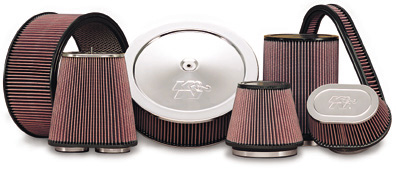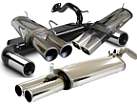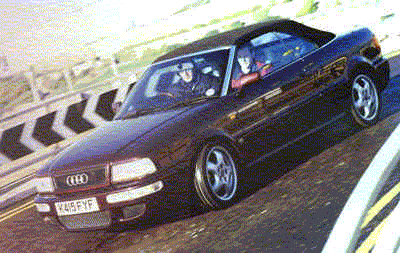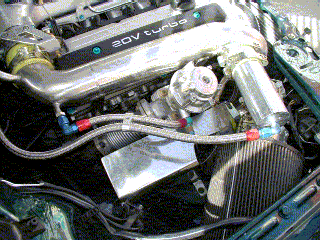|
Introduction | Engine | Transmission | Brakes | Suspension | Electrical Engine Modifications |
|
These are the things often done first in the greed for speed, but suspension and brake improvements should of course be performed BEFORE any serious modifications of the engine's output ! A heavily modified S2 can deliver in excess of 400bhp, and a simple firmware revision to the ECU will provide 270-280bhp, so beefier running gear (especially brakes) are a necessity if you want to keep all that extra horsepower under control. All of this aftermarket tuning milarkey can severely affect your insurance policy, so it is best to take advice on insurance premiums if you wish to modify your S2 for road use. It's all too easy to get fooled by some of the hype from tuning companies about this chip, that chip and a multitude of other bolt-on parts. Power and torque gains are often expressed at peak points. Only the most reputable tuners will provide performance information across the engine's entire dynamic range. Needless to say, torque is more important than power so look especially for useful torque increases at the low-mid ranges on ECU upgrades that are destined for road use. In addition, many so called engine improvements can have negative side effects, such as reduced fuel economy, increased engine wear and additional turbo-lag when caught off-boost. These need to be carefully understood along with any proposed modifications. Ideally, I would like to include a number of real-world case studies of some of the aftermarket options from S2 owners around the world to objectively determine the before and after performance. I've tried to group the modifications into three main categories : MILD - Useful performance gains that are simple and relatively cheap (~ 5-10 BHP) MEDIUM - More involving options to provide serious performance benefits (~ 50 BHP) RAMPANT - At the top of the price and complexity scale for ultimate gains (~ 100-200 BHP) |
|
MILD
Air filters and free-flow exhaust systems generally make up this category. |
|
|
Not everyone is a fan of the 'performance' air filters but they are available for the S2. The basic concept of a foam or cotton gauze air filter is to flow more air into the engine than a cheap paper element. However, some people are uncomfortable with the level of particle protection that this type of filter offers in comparison with traditional paper filters.
K&N will of course tell you that their oil-doused cotton gauze filters provides equal protection to paper filters whilst maintaining better airflow. As always - YOU decide ! A K&N part number for the ABY engined S2 is 33-2029 (To be confirmed). Jetex also list the F308185 for both S2 engines. Believe this is a foam style filter. An option for an oil-free cotton filter is made by Green Air Filters . Part P606839 for the S2.
Dyno runs to follow... |
As for exhaust
systems, a few manufacturers offer a system for the Audi S2. These are
generally of the stainless steel variety and can be made available as a
'catback' system or one with a pair of cat bypass pipes. The latter is preferable
for cars destined for the race track or rally stage.
AFAIK, road going exhausts in the UK must retain catalysers if the car was registered after 1993. To my knowledge, a healthy S2 should easily pass the current emissions tests in the UK without the CATs but unfortunately its only legal to 'remove' the CATs on cars registered before 1993 in the UK. Check with local legislators to ensure you don't get your collar felt.
Exhaust systems are available from - Milltek in the UK, currently listing a stainless system with or without CAT bypass pipes on the 5-speed S2. A system for the 6-speed S2 AVANT is apparently now available, but the S2 Coupe system is still 'in development' at time of writing. AMD, also in the UK, list a system for the S2. Claims to be built by same specialist manufacturer of systems to Rolls Royce. Latest info is that AMD actually supply the Milltek system for the S2. A system also seems to be available from Scorpion. More info to follow on this one also.
Dyno runs to follow... |
|
Consider the RS2 ! The ADU engine of the RS2 Avant is the ultimate factory specification of Audi five cylinder turbo engine. No surprise that it represents the last in the lineage of the evolution of Audi's turbocharged I-5 engine. The technical assistance from the turbo gurus at Porsche was used to develop the RS2 engine so it is worth studying how they achieved figures of 315BHP by modifying the induction, exhaust and ECU systems of the ABY engine which seeded the ADU motor. First off - good news for ABY owners, the short engine of the ADU motor is identical to the ABY. That puts great confidence into the minds of ABY owners wondering how much their standard 'bottom end' will take. The ABY internals can comfortably handle > 315bhp if the software and hardware is there to create it ! The clutch and gearbox is another question, which is considered elsewhere, but there is concensus that the Torsen quattro system can handle torque outputs in the region of 450Nm. It is worth noting that the RS2 has a heavier duty clutch than the ordinary S2. In addition, the ADU and ABY engine both utilise the same direct ignition technology with tiny coil packs at each spark plug, so much of the electrical wiring in the RS2 engine bay is common with the ABY-S2. Details to follow... The magic of the RS2 is in the ancillary components bolted onto the engine : Larger turbocharger (K24/28 hybrid versus the K24 in the 3B and ABY motors) Larger intercooler (reducing heat soak on the inlet side) Modified exhaust camshaft profile Modified exhaust manifold Modified inlet manifold Different mass airflow meter (MAF) Higher flowing fuel injectors Higher spec fuel pump Modified fuel, ignition and boost maps in the ECU I took some time to study much of the engine part information on the 3B, ABY and ADU motors to get a fuller understanding of their evolution and guage what parts are common and which needed to be modified for the RS2. Here is a summary of my findings. It is not an exhaustive list, but it is reasonably extensive. I was particularly interested to note that the same cylinder head and valves are used on all three engines. In fact, of the 24 engine components listed below, the 3B, ABY and ADU share 8 parts. A further 6 components are common on the ABY on the ADU motors. When time permits, I shall also investigate the AAN engine from the UrS4, as it appears to have a great deal in common with the ABY. The biggest difference on the UrS4 is that the bigger engine bay of the Audi 100 allows for a much less constrictive route for the air intake plumbing that also benefits from a larger intercooler (I think).
So if you have the time, the money and inclination, an RS2 power plant can be easily cloned with a willing ABY motor and a very deep pocket for shiny new RS2 parts - unless you happen to find a rear-ended RS2 in a breakers yard ! It is also possible to upgrade a 3B engine to RS2 specification, but there are significant complexities with respect to differences in the ignition systems of these two engines such that the prospective builder is well advised to simply use the wiring loom from the ABY or ADU engine. In addition the cylinder head cover of the 3B engine is different from that found on the ABY and ADU motors to accomodate the direct ignition packs attached to the spark plugs. A timing reference sensor on one of the camshafts, used on the ABY & ADU engines, would also need to be added to the cylinder head from a 3B motor - this makes the distributor on the 3B->RS2 conversion entirely redundant ! Visitors to the S-Cars and the
20V_Kruemme
mail lists will know of Tommy Arnberg's success with a 3B -> ADU conversion
(for a modified Audi 200TQ) which retained much of the original 3B wiring
loom before an ECU from the ADU was grafted into it. No mean feat, but
it is not recommended for those without solid automotive electronic knowledge
and plenty of time on your hands. |
|||||||||||||||||||||||||||||||||||||||||||||||||||||||||||||||||||||||||||||||||||||||||||||||||||||
|
More more more ... For even more extreme power gains, you need to look at vendors such as MTM who offer very high performance upgrades to the 20V I-5 engine. These are definitely not for the faint-hearted, and the obvious insurance nightmares for road use probably consign these sort of upgrades to the domain of motorsport use only. A reasonably good description of the 'RSR' conversion for the S2 with a special hybrid turbo build from MTM can be found here . Bizarrely, MTM actually branded this conversion the RS2 until Audi launched the real thing. Its claimed that MTM's RSR conversion has more power, more torque and less turbo lag than the factory RS2. It's worth noting that this conversion uses an even larger intercooler from the famous S1 and that the intake tracts are suitably shortened to minimise pressure drop and turbo lag. For the latter, read that the throttle valve is on the left side of the engine, instead of the complicated route that the air finds its way into the right side of the S2 and RS2 engines, courtesy of much simpler plumbing. Very reminiscent of the AAN engine in a UrS4... Another example of the left side air intake is demonstrated effectively on one of Dialynx's short sport UR quattros. The photograph here shows the 20V engine with a monster hybrid turbo installation (guessing KKK26/KKK27) complete with huge Samco hosing thru a large intercooler to that special inlet manifold. Note also the heat-wrap sleeving on the exhaust manifold which helps keep under bonnet temperatures under control. |
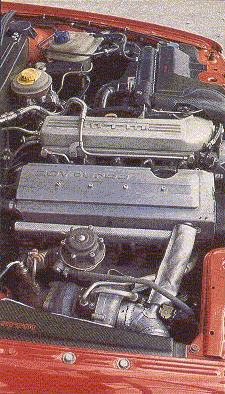
|
|
One example of a fairly wild 20V turbo implant with 428bhp into an Audi Cabriolet (of all things) along with a quattro drivetrain is documented at Kim Collins' site.
|
A trip to the Nordic Audi site, despite the language problems, often turns up a few hotrods. |
Last Updated 18th September 2002
